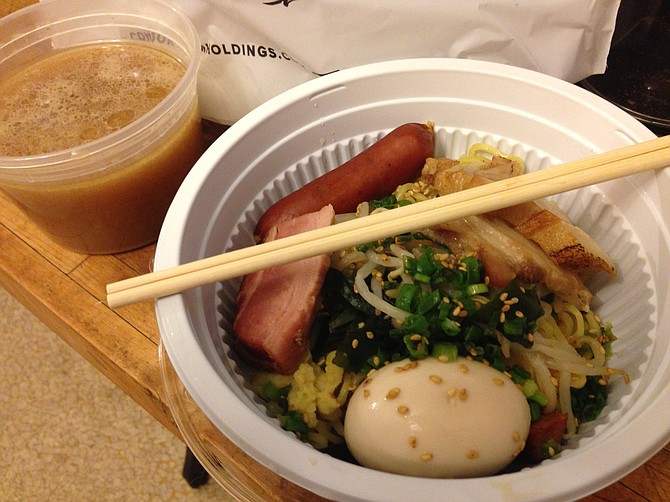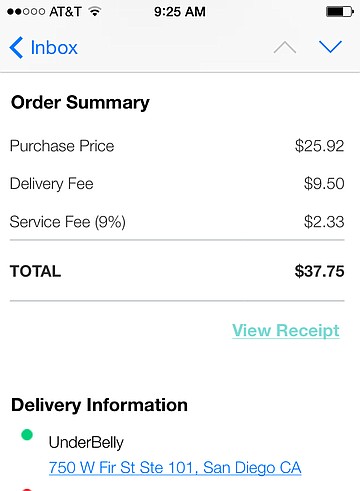 Facebook
Facebook
 X
X
 Instagram
Instagram
 TikTok
TikTok
 Youtube
Youtube

In keeping with my ongoing exploration of smart phone food delivery apps, I had to make my way to Postmates, a service that picks up where Uber leaves off — imagine a fleet of Uber drivers are out there waiting for you to order dinner from a restaurant and then rush it to you once it’s ready.
I initially struggled with the visual interface of the app because it seemed like every time I navigated back to the main menu, the list of restaurant options in my area changed. It took me a while to realize that’s because there’s virtually no limit to my restaurant options. In kind of a weird or ingenious twist, this app equips its drivers with both a smart phone and a prepaid credit card, so it doesn’t matter where you order from — you’ll pay the app, and your driver will actually pay the restaurant separately when he or she picks up your meal.
To that end, it doesn’t have to be a restaurant, as the service’s FAQ explains you may order something from any retail shop and in some cases even have your driver pick up craigslist purchases. And it doesn’t have to be dinner time either. The app claims to operate 24/7, so in theory you might order a 3 a.m. California burrito delivered while you are drunk and the following morning donuts and ibuprofen to help with your hangover.

I point out these scenarios because being unable to get your own food or medicine might be the only thing that would convince me to fork over the kind of delivery charges at play here. I ordered ramen from Underbelly on a rainy Saturday night and paid a total of $11.83 for the delivery — $9.50 based on distance to the restaurant (three miles) and a 9% “service fee.” The actual order — two ramens with oxtail dumplings — cost 12 bucks each before tax. And that’s not including tip.
Granted, as with Uber, Postmates says that a tip is not necessary. It also forbids you from tipping in cash, insisting that if you do tip, you should do so through the app. On the first point: I would like to feel like this is true, but sending someone away from my doorstep in the rain without a tip would require me to be some high level of jerk. On the second point, let’s just say there’s no record on whether or not I am such a jerk.
Ultimately, the app worked as promised. I stayed dry, watched some playoff basketball uninterrupted, received my ramen with no spillage whatsoever, and was able to order everything with a few simple movements of my thumb. Were I rich and lazy, I might actually overuse this service: morning coffee, charcuterie plates, bags of ice, Q-tips, and a jar of pickles might all be rushed to my door within an hour of requesting it, thanks to the gopher-on-demand service.
As it turns out, I’m just lazy, and therefore priced out. Especially if I encountered another Uber-ism: surge pricing. I hate to think what those three miles of driving would cost early on a Friday evening. At some point, it might prove cheaper to Uber myself to the restaurant and back.


In keeping with my ongoing exploration of smart phone food delivery apps, I had to make my way to Postmates, a service that picks up where Uber leaves off — imagine a fleet of Uber drivers are out there waiting for you to order dinner from a restaurant and then rush it to you once it’s ready.
I initially struggled with the visual interface of the app because it seemed like every time I navigated back to the main menu, the list of restaurant options in my area changed. It took me a while to realize that’s because there’s virtually no limit to my restaurant options. In kind of a weird or ingenious twist, this app equips its drivers with both a smart phone and a prepaid credit card, so it doesn’t matter where you order from — you’ll pay the app, and your driver will actually pay the restaurant separately when he or she picks up your meal.
To that end, it doesn’t have to be a restaurant, as the service’s FAQ explains you may order something from any retail shop and in some cases even have your driver pick up craigslist purchases. And it doesn’t have to be dinner time either. The app claims to operate 24/7, so in theory you might order a 3 a.m. California burrito delivered while you are drunk and the following morning donuts and ibuprofen to help with your hangover.

I point out these scenarios because being unable to get your own food or medicine might be the only thing that would convince me to fork over the kind of delivery charges at play here. I ordered ramen from Underbelly on a rainy Saturday night and paid a total of $11.83 for the delivery — $9.50 based on distance to the restaurant (three miles) and a 9% “service fee.” The actual order — two ramens with oxtail dumplings — cost 12 bucks each before tax. And that’s not including tip.
Granted, as with Uber, Postmates says that a tip is not necessary. It also forbids you from tipping in cash, insisting that if you do tip, you should do so through the app. On the first point: I would like to feel like this is true, but sending someone away from my doorstep in the rain without a tip would require me to be some high level of jerk. On the second point, let’s just say there’s no record on whether or not I am such a jerk.
Ultimately, the app worked as promised. I stayed dry, watched some playoff basketball uninterrupted, received my ramen with no spillage whatsoever, and was able to order everything with a few simple movements of my thumb. Were I rich and lazy, I might actually overuse this service: morning coffee, charcuterie plates, bags of ice, Q-tips, and a jar of pickles might all be rushed to my door within an hour of requesting it, thanks to the gopher-on-demand service.
As it turns out, I’m just lazy, and therefore priced out. Especially if I encountered another Uber-ism: surge pricing. I hate to think what those three miles of driving would cost early on a Friday evening. At some point, it might prove cheaper to Uber myself to the restaurant and back.
Comments